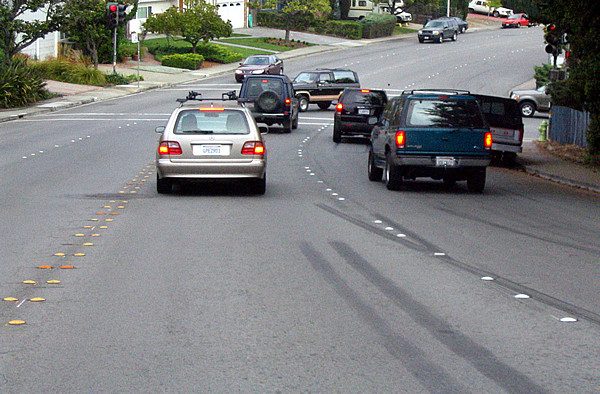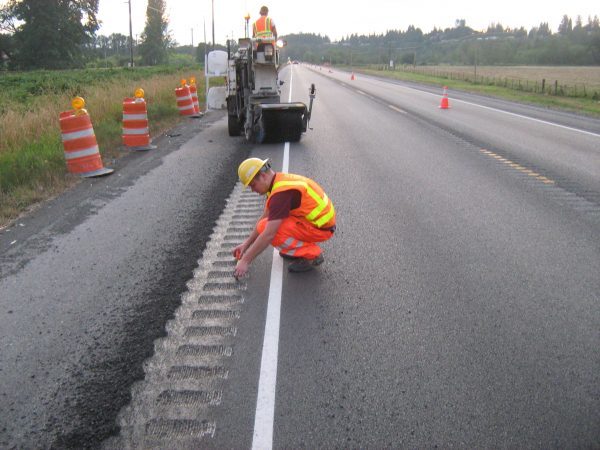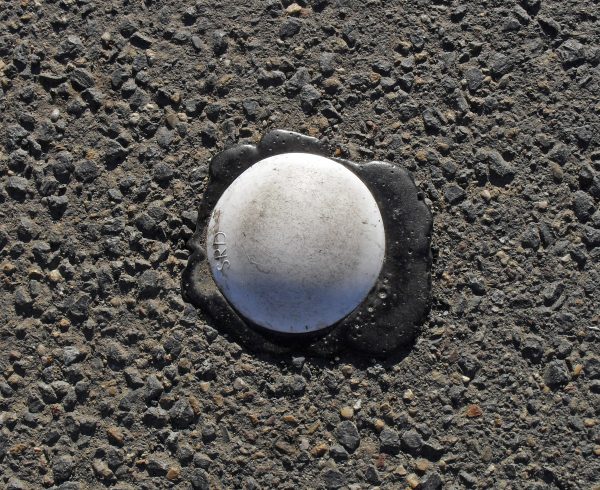The 1950s postwar boom led to rapid increase of cars (and collisions) on California roads and, in turn, the development of Botts’ dots, a design solution that is just now starting to be phased back out.

Developed by Caltrans, the dots (sometimes referred to as “turtles” in the Pacific Northwest or “buttons” in Texas) were named after Dr. Elbert Dysart Botts of the California Department of Transportation (Caltrans). They were designed to address lane visibility, especially in the rain, but also serve to spook drifting drivers back to alertness (like rumble strips, embedded in pavement alongside roads).

When the first raised dots hit the streets, there were some serious issues — made of glass and nailed into the ground, they would break loose at times leaving nails exposed to puncture tires. A special epoxy created by Botts’ team helped solve the problem, allowing the dots to be affixed more easily and safely along highways and freeways.

In 1966, the California State Legislature mandated the use of the dots in all non-snowfall areas. Today, over 25,000,000 exist across the state, interspersed with raised reflective pavement markers. Some are placed over painted lines while others replace paint entirely. For a long time, these were placed by hand right next to active traffic, though safer automated solutions have also been developed (see video below).
Meanwhile, Botts’ dots have also migrated to other, mainly low-snowfall states (not only do they disappear under snow but they are also easily dislodged by plows). In snow-prone states, raised reflective markers are sometimes placed in recessed slots to avoid destruction. Other countries have adopted the dots over the years, too.

Now, however, Botts’ dots are on the chopping block, at least in California. Critics say the ceramic buttons aren’t very reflective, don’t last very long and may pose problems for autonomous vehicles.
The dots may persist in some cities, but are being phased out on state roads where heavy use forces frequent replacement (initially every ten years, but these days as often as every six months).
Better raised reflective technology will continue to replace the dots and a rumble effect will still exist, though it won’t be quite as frequent or pronounced — a driver passing over a new generation lane divider will continue to hear two bumps per second when traveling at 60 MPH.



Comments (6)
Share
When I drove the Blue Ridge Parkway in VA years ago the roads out there had these amazingly bright recessed reflectors built into the road. They were so bright I wasn’t sure if they were just really reflective or solar powered. But trust me, in the winter you want to know where the road is or you are going off a very steep cliff.
In Ireland & UK the reflectors in the road a pretty clever design, they are recessed into the road, if a car drives over them the get pushed down into the recess and this cleans the reflective lense.
We call them ‘cats eyes’, my dad says the guy who invented them saw the very of a dead cat on the road :D
France had dots marking pedestrian passages until the 80s, the passages were called “nailed passages” (passages cloutés), as the dots looked like nail heads.
It seems that the nailed passages were a Swiss invention in 1932…
The design of pedestrian passages is interesting dating far back (elevated passages in Pompei…).
Maybe there is a story on placebo buttons for requesting a red light at pedestrian passages: who ever thought of that?.
Better reflective technologies? From what I’ve seen in California, that consists of reflective paint (and we all know that paint wears down fairly fast too). It looks like California is using cost to obfuscate safety, when in reality there is no agreed-upon substitute in place for the Botts’ dots!
I have seen ordinary lane paint replace the Botts’ dots in places where repaving has occurred, notably outside of Palmdale along Lake Elizabeth Rd. in Northwest Los Angeles County. Ironically, in the place where the reflective dots were removed there are signs indicating the road curves AND that the road is subject to ice. Apparently the people who service these roads — CalTrans? — doesn’t appreciate that areas of the Antelope Valley and surrounding communities are, in fact, subject to snow!
From what I have seen, *mildly* reflective paint is what has replaced Botts’ dots. Here’s the problem, especially in rural areas without a lot of city lighting: The reflective dots showed up better in car headlines than the paint. Moreover, the fact that the dots protrude from the highway makes it helpful to alert drivers who stray over the line. This is critical in areas (like the above described) where the highway is only two lanes, and there is no barrier (median) to prevent cars from straying into oncoming traffic.
The State of California may want to phase out Botts’ dots to save money but the question is will they eat up their cost savings in lawsuits from injured drivers (to include, potentially, class action lawsuit)?
Suggestion: Before the Botts’ dots are removed entirely, the minimum the State should do is agree on what “technology” should replace them. The haphazard implementation of what is and is not reflective, without awareness for local weather conditions, is a problem.
I agree. Roads without the dots are much harder to see at down and twilight. The only time visibility is acceptable reflective paint only is on new asphalt. But they don’t last, don’t reflect well with headlights and lose visibility when covered in rain. This is much worse when Caltrans remove the dots and remark lanes. They don’t clean the old marks properly and leave multiple lines in different directions. They are doing a disservice to drivers by the misguided cost savings effort.
Sad to see them go as I owe them my life while drifting across a lane once on Washington 520 after falling asleep on the wheels.